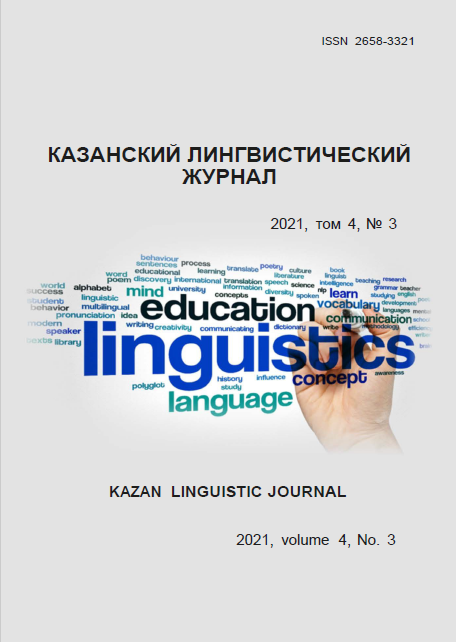Lexical markers of the scientific sport discourse (based on “science of gymnastics journal”)
https://doi.org/10.26907/2658-3321.2021.4.3.366-379
Keywords:
sport discourse, scientific discourse, professional discourse, communication, lexical marker, term, scientific lexisAbstract
The purpose of this article is to identify lexical means that function as markers of scientific sport discourse. The research was based on 22 scientific articles of the English-language publication “Science of Gymnastics Journal”. The relevance of the study is determined by insufficient attention of linguists to the scientific component of sport discourse and the necessity to describe its purpose, subject, communicants and linguistic means used in scientific texts. A scientific article is a text of purely professional sport discourse, created by specialists and available for understanding only by a knowledgeable reader. Linguistic analysis of articles makes it possible to identify the most frequent lexemes, significant from the point of view of information content, the communication purpose and the speech organization, and classify them thematically and functionally. In the course of the study, the methods of semantic, contextual and discourse analysis were employed, the results of which make it possible to assert that the terms are key semantic units. At the same time, the presence of sport terms proves that the studied texts are related to sports discourse, and the functioning of terms of other spheres characterizes these texts as interdiscursive. Introductory phrases, means of expressing evaluation and abstract vocabulary are presented as traditional lexical elements of a scientific text. Functioning of the considered units in the text determines such characteristics of a scientific text as information content, coherence, density, the tendency towards generalization and abstraction.
References
References
Zharkova U.A. To the problem of interdiscursivity of «sports announce-ment» type of text (based on the German-language texts). Nizhnewartovsk: Vestnik Nizhnevartovskogo gosudarstvennogo universiteta. 2014; (4): 21–29. (In Russ.)
Popova N.B. Report’s communicative and speech strategies as a genre of mass media sporting discourse. Chelyabinsk: Vestnik Chelyabinskogo gosudarstvennogo universiteta. 2017; 12(408): 159–165. (In Russ.)
Sadykova A.G., Zaripov A.R. Zoomorphic metaphor in sports media dis-course: by the material of the English and Russian mass media. Kazan: Filologicheskie nauki. Voprosy teorii I praktiki. 2017; 11-1(77): 155–158. (In Russ.)
Komleva L.А. Precedent names functioning in sport discourse (based on sports autobiographies and memoirs). Chelyabinsk: Vestnik Chelyabinskogo gosudarstvennogo universiteta. 2009; 34(172): 61–66. (In Russ.)
Zilbert A.B. Sport discourse: points of intersection with other discourses (problems of intertextuality). Yazyk, soznanie, kommunikatsiya. Мoscow: MAKS Press. 2001; (19): 103–112. (In Russ.)
Kazarina N.B. Linguocultural types of sports discourse in the minds of modern Russian speakers. Krasnodar: Svyazi s obshchestvennost'yu v sporte: obra-zovanie, tendentsii, mezhdunarodnyi opyt. 2014; (6): 117–122. (In Russ.)
Karasik V.I. Language circle: personality, concepts, discourse. Volgograd: Peremena; 2002. (In Russ.)
Mukhina Yu. N. The Effect of the Scientific and Popular Science Discourse on the Basic Cognitive Level. Saratov: Izvestiya Saratovskogo universiteta. 2019; 19(1): 25–29. (In Russ.)
Perevolochanskaya S.N. The image of the author in the scientific discourse: metaphorization as a means of forming scientific abstractions. Ivzestia Volgogradskogo State Pedagogicheskogo universiteta. 2019; 2(135): 101–105. (In Russ.)
Nuzhnova Е.Е., Babaeva T.B., Zhukovskaya N.V. Argumentation strategy in scientific discourse. Perm’: Vestnik Permskogo Nazional’nogo issledovatel’skogo politehnicheskogo universiteta. 2019; (2): 57–64. (In Russ.)
Leandro C., Ávila-Carvalho L., Sierra-Palmeiro E., Bobo M. Accuracy in judgment the difficulty score in elite rhythmic gymnastics individual routines. Science of Gymnastics Journal. 2015; 7(3): 81–93.
Jakše Bo., Jakše Ba. Potential benefits of consuming omega-3 fatty acids for artistic gymnasts. Science of Gymnastics Journal. 2017; 9(2): 127–152.
Heinen T., Brinker A., Mack M., Henning L. The role of positional environmental cues in movement regulation of Yurchenko vaults in gymnastics. Science of ymnastics Journal. 2017; 9(2): 113–126.
Delaš Kalinski S., Atiković A., Jelaska I., Milić M. (2016). Performance analysis of female gymnasts’ vault in elite competitions from 2008 to 2015. Science of Gymnastics Journal. 2016; 8(2): 109–123.






